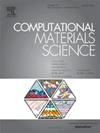Understanding and design of interstitial oxygen conductors
IF 3.3
3区 材料科学
Q2 MATERIALS SCIENCE, MULTIDISCIPLINARY
引用次数: 0
Abstract
Highly efficient oxygen-active materials that react with, absorb, and transport oxygen is essential for fuel cells, electrolyzers and related applications. While vacancy-mediated oxygen-ion conductors have long been the focus of research, they are limited by high migration barriers at intermediate temperatures (400–600 °C), which hinder their practical applications. In contrast, interstitial oxygen conductors exhibit significantly lower migration barriers enabling higher ionic conductivity at lower temperatures. This review systematically examines both well-established and recently identified families of interstitial oxygen-ion conductors, focusing on how their unique structural motifs such as corner-sharing polyhedral frameworks, isolated polyhedral, and cage-like architectures, facilitate low migration barriers through interstitial and/or interstitialcy diffusion mechanisms. A central discussion of this review focuses on the evolution of design strategies, from targeted donor doping, element screening, to physical-intuition descriptor material screening and machine learning approach, which leverage computational tools to explore vast chemical spaces in search for new interstitial conductors. The success of these strategies demonstrates that a significant, largely unexplored space remains for discovering high-performing interstitial oxygen conductors. Crucial features enabling high-performance interstitial oxygen diffusion include the availability of electrons for oxygen reduction and sufficient structural flexibility with accessible volume for interstitial accommodation and migration. This review concludes with a forward-looking perspective, proposing a knowledge-driven methodology that integrates current understanding with data-centric approaches to identify promising interstitial oxygen conductors outside traditional search paradigms. These approaches are expected to significantly accelerate the development of high-performance interstitial oxygen conductors for a variety of oxygen-active applications, ultimately paving the way for more efficient and sustainable energy technologies.

对间隙氧导体的理解和设计
高效的氧活性材料,反应,吸收和运输氧气是必不可少的燃料电池,电解槽和相关应用。虽然空缺介导的氧离子导体一直是研究的焦点,但它们在中间温度(400-600°C)下的高迁移障碍限制了它们的实际应用。相比之下,间隙氧导体表现出明显较低的迁移障碍,从而在较低温度下具有较高的离子电导率。这篇综述系统地研究了已经建立的和最近发现的间隙氧离子导体家族,重点研究了它们独特的结构基序,如共享角多面体框架、孤立多面体和笼状结构,如何通过间隙和/或间隙扩散机制促进低迁移障碍。本综述的核心讨论集中在设计策略的演变上,从靶向供体掺杂、元素筛选到物理直觉描述子材料筛选和机器学习方法,这些方法利用计算工具探索广阔的化学空间,寻找新的间隙导体。这些策略的成功表明,在发现高性能间隙氧导体方面仍有很大的未开发空间。实现高性能间隙氧扩散的关键特征包括氧还原电子的可用性和足够的结构灵活性,以及间隙调节和迁移的可访问体积。本综述以前瞻性的视角总结,提出了一种知识驱动的方法,该方法将当前的理解与以数据为中心的方法相结合,以识别传统搜索范式之外有前途的间隙氧导体。这些方法有望显著加速用于各种氧活性应用的高性能间隙氧导体的开发,最终为更高效和可持续的能源技术铺平道路。
本文章由计算机程序翻译,如有差异,请以英文原文为准。
求助全文
约1分钟内获得全文
求助全文
来源期刊

Computational Materials Science
工程技术-材料科学:综合
CiteScore
6.50
自引率
6.10%
发文量
665
审稿时长
26 days
期刊介绍:
The goal of Computational Materials Science is to report on results that provide new or unique insights into, or significantly expand our understanding of, the properties of materials or phenomena associated with their design, synthesis, processing, characterization, and utilization. To be relevant to the journal, the results should be applied or applicable to specific material systems that are discussed within the submission.
 求助内容:
求助内容: 应助结果提醒方式:
应助结果提醒方式:


